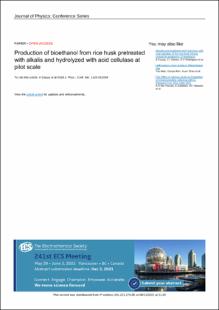Production of bioethanol from rice husk pretreated with alkalis and hydrolyzed with acid cellulase at pilot scale
Artículo de revista
2018-12-07
Journal of Physics: Conference Series
Reino Unido
Rice husk (RH) is the main biomass byproduct of the rice industry, so much that it corresponds to 20% of the total cereal production and is generally considered a waste. Due to its content of cellulose and hemicellulose, the RH has a great potential for its alternative use in the production of bioethanol, since it has a great advantage with respect to the conventional raw materials used (sugar cane, corn, beet and sweet sorghum, among others), given that this lignocellulosic material is abundant and does not compete with the food industry. The objective of this work was to obtain bioethanol from rice husk at a pilot scale, taking advantage of its cellulose and hemicellulose content. For this, a sample of 450g of RH was taken, which was pretreated with a 2.00% w/v NaOH solution and subsequently hydrolyzed with acid cellulase (CFB3S). The alcoholic fermentation of total reducing sugars (TRS) obtained in the enzymatic hydrolysis was carried out with Saccharomyces cerevisiae, finally, the fractional distillation of the must was carried out, by means of which four bioethanol samples were obtained with concentrations of 71.3% v/v, 30.0% v/v, 10.3% v/v, and 5.3% v/v of alcohol, which when mixed produced a sample of 95mL of solution with a concentration of 27% v/v alcohol (4.70g/100g of RH).
Descripción:
Production of bioethanol from rice husk pretreated with alkalis and hydrolyzed with acid cellulase at pilot scale.pdf
Título: Production of bioethanol from rice husk pretreated with alkalis and hydrolyzed with acid cellulase at pilot scale.pdf
Tamaño: 524.3Kb
 PDF
PDF
 LEER EN FLIP
LEER EN FLIP
Título: Production of bioethanol from rice husk pretreated with alkalis and hydrolyzed with acid cellulase at pilot scale.pdf
Tamaño: 524.3Kb
 PDF
PDF
 LEER EN FLIP
LEER EN FLIP















